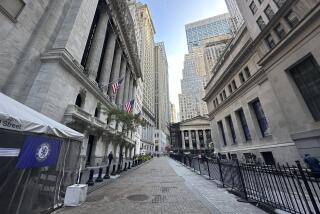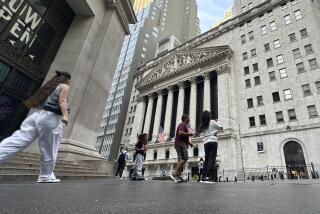Big Banks Hike Prime Lending Rates to 9.5% : Interest Highest Since Early 1986; Second Boost Since February May Signal a Slow Upward Drift
NEW YORK — Many of the nation’s biggest banks boosted their prime lending rates Thursday to 9.5% from 9%, marking the second general increase in the prime since February and a further sign that interest rates are on a slow upward drift.
The new rate is the highest since March, 1986, for the prime, which is widely watched because it is used by banks and other lenders to calculate interest rates on a variety of business and consumer loans. The round of hikes was first announced by New York’s big Chase Manhattan Bank, followed by others that included Citibank, Manufacturers Hanover Trust, First National Bank of Chicago, Bank of America, First Interstate and Bank of New York.
The lenders have seen steady increases in their borrowing costs since February, when the Federal Reserve Board began tightening credit to counteract the inflation that has been building in the strong economy. Many economists believe that the prime rate may be raised at least once more before year’s end as the Fed further nudges rates up to brake economic growth.
“Rates are headed up--you can see it in all the statistics that show just how strong this economy is,” said Robert Dederick, an economist with Northern Trust Bank in Chicago and a former U.S. undersecretary of commerce.
Expectations that higher rates are ahead were confirmed in many minds Wednesday, when Fed Chairman Alan Greenspan told Congress that he believes the Fed might be “well advised to err more on the side of restrictiveness than stimulus” of the economy.
The last boost in the prime rate came May 11, when banks increased it to 9% from an 8.5% rate, where it had stood since February. The rate stood at 9.25% just before last October’s stock market crash, then fell abruptly as the Fed eased credit to buffer the effects of the crash.
Economists said the impact of the rise in the prime would be felt most dramatically by consumers and would probably further slow the growth of consumer spending.
The prime rate used to be defined as the rate banks charged their best corporate customers. But in recent years, the largest corporations have negotiated loans at different rates or turned to other means of financing, while more and more consumer loan rates have been linked to the prime.
Among these are many personal installment loans, auto loans, and the home equity loans that have recently surged in popularity.
The financial strain that this prime hike will mean for many households is evident in the expanding volume of home equity loans: Such loans by large commercial banks, for example, rose to a total volume of about $20 billion by the end of June, up 58% from $12.7 billion last year at this time, Federal Reserve figures show.
“All those people who have been adding home-equity loans to other debts are in for some bad news,” said Paul Getman, director of financial services at WEFA Group, an economics consulting firm in Bala Cynwyd, Pa.
Made to ‘Float’
Consumer loan rates, which used to be fixed, have increasingly been made to “float” up and down with the prime rate or interest rates.
Getman said prime rate increases also tend to hit harder at the younger generation than at their elders. Younger families tend to have more debt, and their debt is in newer borrowings that fluctuate with the prime and other rates.
Their parents’ generation, in contrast, tends to be carrying older, fixed-rate loans, or to be debt-free, he said. Members of that older generation also are often drawing interest on assets that pay more as rates rise, Getman observed.
He said that while consumer spending continues to grow, its rate of expansion is half what it was in 1986. Consumer spending grew 4.2% in 1986 but only 1.9% last year and is expected to grow about that much this year as well, according to Getman.
Even though large corporations no longer borrow from banks at the prime rate, as they once did, many medium-sized and small businesses are still directly affected by the prime’s movements, economists noted. “For a lot of businesses, this hike will be the first time they feel the effect of rising rates,” said Walter Joelson, an economist and a vice president with General Electric Co.
Points Above Prime
A typical loan to a medium-sized or small business might be priced at three percentage points above the prime.
Increases in the prime rate also have a psychological effect on the economy, influencing lenders to increase their rates and persuading some borrowers that they should borrow less, economists said.
The financial markets have expected an increase in the prime rate for some time and took the news in stride. Indeed, the Dow Jones industrial average, which plummeted almost 38 points in response to the prime hike in May, gained 9.25 points in Thursday’s stock trading.
The bond market was similarly unflapped by the news, analysts said.
Traders on the stock and bond markets have expected the increase in the prime as a result of recent increases in other rates, particularly the federal funds rate, which is the Fed’s rate on overnight loans to member banks.
More to Read
Inside the business of entertainment
The Wide Shot brings you news, analysis and insights on everything from streaming wars to production — and what it all means for the future.
You may occasionally receive promotional content from the Los Angeles Times.











